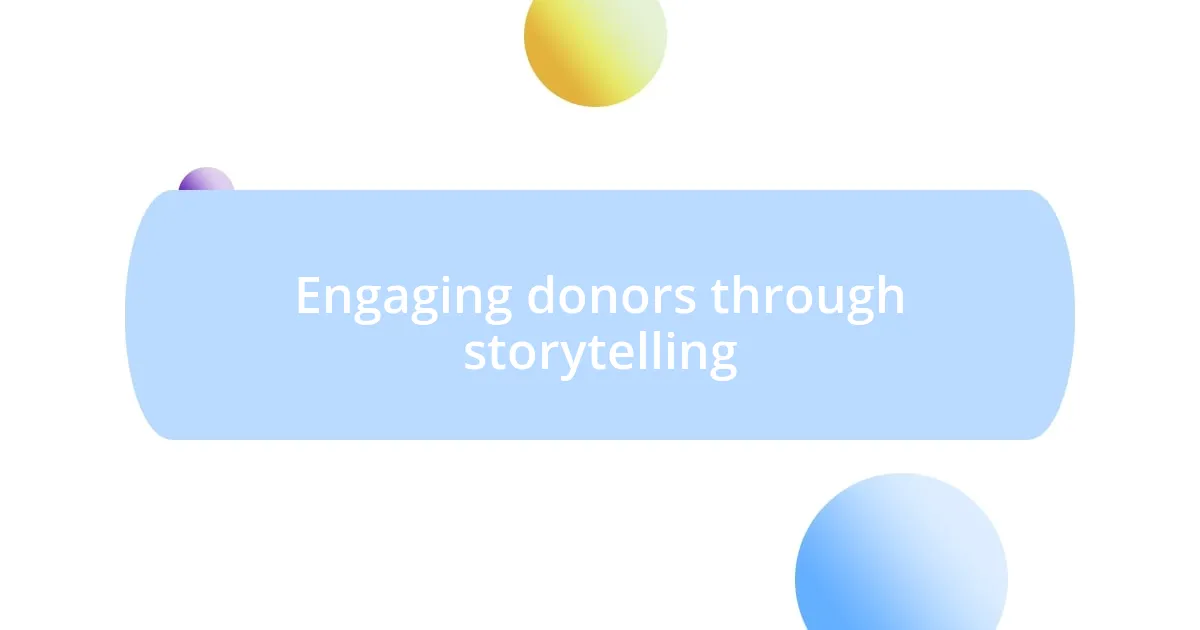Key takeaways:
- Break fundraising goals into manageable, community-focused objectives to enhance engagement and satisfaction.
- Identify target audience needs through surveys and data analysis to tailor communication strategies effectively.
- Utilize digital tools and storytelling to create meaningful connections with donors, fostering a sense of community and ownership.
- Measure fundraising success through relationship-building and qualitative feedback, not just financial contributions.

Understanding fundraising goals
Understanding fundraising goals can often seem daunting, but I’ve found that breaking them down into smaller, manageable objectives really helps. For instance, when I was leading a campaign, we started by setting a goal to raise just $5,000 in the first month. It felt realistic and achievable, and hitting that target ignited excitement in our team. Have you ever felt that rush when you reach a milestone? It’s exhilarating!
As I’ve navigated the fundraising landscape, clarity in my goals has been crucial. I remember one campaign where we initially aimed for a high dollar amount, thinking that would be the key to success. However, we quickly realized that focusing on community engagement and building relationships was far more rewarding. It made me wonder—are we always prioritizing the right aspects in our strategies?
One important lesson I’ve learned is that fundraising goals should not just be numbers on a page; they should reflect the mission and values of the organization. For example, when we involved our supporters in a community project alongside our fundraising efforts, we not only met our goal but also strengthened our connections. Have you considered how your goals align with your community’s needs?

Identifying target audience needs
Identifying the needs of your target audience is fundamental to successful fundraising. In my experience, surveys and personal conversations can reveal what motivates your supporters. I remember a time when we hosted a focus group, and the insights we gained were eye-opening. People shared why they felt connected to our cause, and it helped us tailor our messaging. Have you ever thought about what truly drives your audience?
Understanding demographic factors is also critical. For instance, younger audiences might prefer digital engagement, while older generations may value face-to-face interactions. I once noticed a stark contrast in our outreach methods when targeting different groups for a charity event. This taught me that a one-size-fits-all approach simply doesn’t work in fundraising. It’s vital that we adapt our strategies to meet the different expectations and preferences of our supporters.
A final approach I’ve found effective is analyzing past engagement data. By reviewing which campaigns resonated most, I’ve been able to craft future initiatives that better align with audience interests. I recall poring over data from previous drives, discovering that themed events significantly boosted participation. This insight helped me rethink our strategies, focusing on what genuinely excites our donors.
| Audience Type | Preferred Engagement Method |
|---|---|
| Millennials | Digital platforms and social media |
| Generation X | Email Newsletters |
| Baby Boomers | Face-to-face meetings and print communication |

Building an effective fundraising strategy

Building an effective fundraising strategy
Creating an effective fundraising strategy is like crafting a recipe; every ingredient must blend perfectly. I remember when we were preparing for a major gala – it was nerve-wracking but exhilarating. We meticulously planned every detail, from the theme to the guest list, ensuring every element reinforced our mission. That experience taught me the importance of alignment between our fundraising tactics and our core values. It’s all about connecting the dots.
Here are some key components that I found essential for building a potent fundraising strategy:
-
Clear objectives: Define what success looks like, creating specific, measurable goals.
-
Engagement strategy: Identify how you will communicate with donors—what channels will you use?
-
Timeline: Set a realistic timeline for milestones to keep the campaign on track.
-
Budgeting: Allocate resources efficiently to avoid overspending and maximize returns.
-
Feedback loop: Establish a system for gathering donor feedback, allowing for continuous improvement.
Each of these elements must work in harmony. One time, for a crucial campaign, we launched a feedback loop halfway through, and the insights we received were invaluable, leading to last-minute tweaks that truly saved the initiative. Have you thought about how these aspects interconnect in your own fundraising journey?

Utilizing digital fundraising tools
Utilizing digital fundraising tools has been a game-changer for me in the nonprofit space. I recall launching our first online campaign—it was thrilling and daunting at the same time. We utilized platforms like GoFundMe and social media for outreach. The connection we fostered digitally felt immediate and real. Have you ever witnessed the energy that a well-timed social media post can create? I’ve seen donations roll in while I was still sipping my morning coffee, which is both exciting and humbling.
As I delved deeper into digital tools, I realized that email marketing is critical for maintaining engagement. I remember sending out a heartfelt newsletter detailing our project updates—what struck me was the flood of responses I received. Supporters not only contributed financially but shared their own stories of why our mission mattered to them. Crafting those emails felt personal, like a conversation with old friends. Have you found that the stories you tell shape the way your audience interacts with your cause?
Another effective tool I’ve embraced is crowdfunding. I vividly remember a project we undertook aiming to improve community resources. By creating a dedicated page, sharing our goals, and continuously updating our progress, we fostered a sense of community ownership. The way people rallied around our mission was both inspiring and emotional. It made me think—how often do we tap into that collective spirit? If you harness the right digital tools, you can turn supporters into activists, making the journey vibrant and impactful.

Engaging donors through storytelling
Engaging donors through storytelling has been one of the most powerful strategies I’ve discovered. I remember sharing a poignant story about a family we helped during a particularly tough winter. Through every single detail—their struggles, hopes, and ultimate triumph—I could feel the room transform. It wasn’t just about numbers; it was about lives touched. Have you ever seen how a simple narrative can breathe life into an initiative? When donors can visualize the impact they’re making, their connection to the cause deepens.
When I recount the story of our first successful project, I still get emotional. We had this small community garden that started from nothing. By sharing the journey of its growth—how it transformed not just the land but relationships and wellness—it struck a chord in potential donors. People genuinely want to be part of something bigger than themselves. I often ask myself: how can we make our message resonate? I believe it’s through creating a tapestry of stories that both inspire and inform. Every donor wants to feel like a hero, contributing to a shared vision.
Another memorable moment was when I incorporated donor testimonials into our campaign narrative. Sharing their experiences not only validated their contributions but made each story feel like a thread in our overarching fabric. It brought a sense of community to our fundraising efforts. I often wonder, do we harness the full potential of these personal connections in our storytelling? After all, nothing captivates quite like the real voices of those we serve, reminding donors that they are part of a meaningful journey.

Measuring fundraising success
Measuring fundraising success often goes beyond just tallying the dollars raised; it also encompasses the relationships forged. During my first campaign, I was initially thrilled when we met our monetary goal, but the real success revealed itself in the stories of engagement. One supporter reached out to share how our cause motivated him to volunteer, turning a single donation into a lasting commitment. Have you ever noticed how those heartfelt connections can be a measure of impact as significant as financial contributions?
In my experience, tracking metrics like donor retention rates has been eye-opening. Early on, I discovered that retaining donors is just as important, if not more so, than attracting new ones. It was enlightening to realize how a simple thank-you call could lead to renewed support the following year. Reflecting on those early relationships, I often think—what concrete steps are we taking to cherish and nurture these connections? The warmth of an ongoing relationship often outweighs the thrill of a one-time gift.
Lastly, I’ve found that qualitative feedback can be a treasure trove for measuring success. During one campaign, we invited feedback through a short survey after our fundraising event. The responses were not just numbers; they were filled with emotion. One person wrote about how our initiative changed her perspective on community involvement. Moments like this made me ask—how can we continue to solicit and act on feedback to improve our efforts? Engaging with the voices of our supporters provides invaluable insights that shape our future strategies.

Reflecting on lessons learned
Reflecting on the lessons learned throughout my fundraising journey has opened my eyes to the power of adaptability. I recall a time when a last-minute change in our event location seemed daunting. At first, I felt overwhelmed, but then the team rallied together, brainstorming creative solutions. This experience taught me that flexibility can transform potential setbacks into opportunities. Have you ever found that a change you thought would derail your plans actually led to something better? The key is to remain open to new possibilities.
One unforgettable lesson is the significance of genuine appreciation for every contributor, big or small. During one campaign, I organized a small thank-you gathering for top donors, but I quickly realized that the smaller donors were just as eager for recognition. Including everyone in our celebration created a warm sense of community, reminding me that gratitude multiplies goodwill. How often do we acknowledge the quieter voices that also drive our mission forward? It made me strive to personalize my acknowledgement efforts, reinforcing our commitment to each supporter’s role.
Finally, the most profound lesson I’ve learned is the importance of storytelling as a tool for connection. I often think back to a time when a donor came up to me after an event, visibly moved by a shared experience that resonated with him. His tears underscored how impactful personal narratives can be. Reflecting on these moments, I ask myself: Are we genuinely tapping into the emotional power of our stories? This realization has inspired me to weave more personal accounts into our fundraising efforts, as they create bridges of understanding and empathy that resonate deeply with donors.














